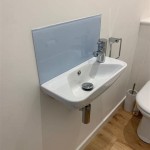Industrial Bathroom Sink Units: Durability and Design for High-Traffic Spaces
Industrial bathroom sink units are specifically engineered to withstand the rigors of high-traffic environments while offering a functional and aesthetically appropriate design. These units are commonly found in commercial settings such as factories, warehouses, schools, hospitals, and public restrooms where durability, ease of maintenance, and hygienic properties are paramount. Unlike residential sinks designed for lighter use, industrial sinks are constructed from robust materials and feature designs focused on practicality and longevity.
The selection of an appropriate industrial bathroom sink unit requires careful consideration of several factors, including the intended usage, frequency of use, space constraints, and budget. The specific requirements of the environment will dictate the necessary features and materials. For instance, a factory setting handling corrosive materials may require a sink constructed from a specialized alloy resistant to chemical degradation, while a school bathroom prioritizes vandal-resistant features.
Key Point 1: Material Selection and Durability
The choice of material is fundamental to the performance and lifespan of an industrial bathroom sink unit. Stainless steel is the most prevalent material due to its exceptional durability, corrosion resistance, and ease of cleaning. Specifically, Type 304 stainless steel, containing chromium and nickel, offers superior resistance to rust and stains, making it ideal for environments exposed to moisture and harsh cleaning agents. The gauge of the stainless steel, which indicates its thickness, also impacts its robustness. Heavier gauges, such as 16 gauge or 14 gauge, provide increased resistance to dents and damage from heavy use.
Other materials used in industrial sink construction include cast iron, vitreous china, and specialized polymers. Cast iron sinks are known for their durability and heat resistance, often coated with a porcelain enamel finish for added protection and aesthetic appeal. However, cast iron is significantly heavier than stainless steel, posing challenges during installation and potentially requiring reinforced support structures. Vitreous china, while more commonly found in residential settings, can be used in lighter-duty industrial applications. It offers a smooth, non-porous surface that is easy to clean but is more susceptible to chipping and cracking than stainless steel or cast iron.
Specialized polymers, such as epoxy resins or molded stone composites, are increasingly used in industrial sink units, particularly in laboratories or environments requiring chemical resistance. These materials can be formulated to withstand exposure to a wide range of corrosive substances and are often lighter than traditional materials like stainless steel or cast iron.
The finish of the sink is also a crucial consideration. A brushed or satin finish on stainless steel helps to conceal scratches and water spots, maintaining a cleaner appearance over time. Powder coating can be applied to cast iron or steel sinks to provide a durable, corrosion-resistant finish in a variety of colors.
Key Point 2: Design and Functionality
The design of an industrial bathroom sink unit should prioritize functionality and ease of use, considering the specific needs of the users. Several design elements contribute to the overall effectiveness of the sink, including the number of stations, the depth and shape of the basins, the type of faucet, and the presence of accessories.
Multi-station sink units are commonly used in high-traffic areas to accommodate a large number of users simultaneously. These units can be configured in linear or circular arrangements, depending on the available space and the flow of traffic. Individual basins should be adequately sized to allow for thorough hand washing without excessive splashing. Deeper basins are generally preferred in industrial settings to contain spills and prevent water from overflowing.
Faucet selection is critical for both water conservation and hygiene. Sensor-operated faucets, also known as touchless faucets, are highly recommended in industrial settings as they minimize the spread of germs and promote water efficiency. Self-closing faucets, which automatically shut off after a set period, are another option for conserving water. The flow rate of the faucet should be carefully considered to balance water savings with adequate rinsing. Low-flow faucets, typically delivering 0.5 gallons per minute (GPM) or less, can significantly reduce water consumption without compromising hand washing effectiveness.
Accessories such as soap dispensers, paper towel dispensers, and hand dryers should be integrated into the sink unit design for convenience and hygiene. Automatic soap dispensers are preferred over manual dispensers to minimize contact and the spread of germs. Paper towel dispensers should be strategically located to prevent dripping water on the floor, which can create a slip hazard. High-speed hand dryers are a popular alternative to paper towels, offering a cost-effective and environmentally friendly drying solution. The placement of these accessories should be carefully planned to ensure accessibility and ease of use for all users.
Consideration should be given to compliance with accessibility standards, such as the Americans with Disabilities Act (ADA). ADA-compliant sinks must meet specific requirements regarding height, knee clearance, and reach range to ensure usability by individuals with disabilities. Wall-mounted sinks are often preferred in ADA-compliant bathrooms as they provide unobstructed knee clearance.
Key Point 3: Installation and Maintenance
Proper installation is essential to ensure the long-term performance and safety of an industrial bathroom sink unit. Installation should be performed by qualified professionals who are familiar with plumbing codes and regulations. The sink unit must be securely anchored to the wall or floor to prevent movement or instability. Adequate drainage is crucial to prevent water from pooling in the basin or overflowing onto the floor. The plumbing connections should be properly sealed to prevent leaks.
Regular maintenance is necessary to keep the sink unit in good working order and to prevent costly repairs. Cleaning the sink regularly with a mild detergent and water is essential to remove dirt, grime, and bacteria. Abrasive cleaners should be avoided as they can scratch the surface of the sink. Stainless steel sinks can be treated with a stainless steel cleaner to maintain their shine and prevent rust. The faucet aerators should be cleaned periodically to remove mineral deposits and ensure proper water flow.
The drainage system should be inspected regularly for clogs and blockages. Hair, soap scum, and other debris can accumulate in the drainpipes over time, reducing water flow and potentially causing backups. A plunger or drain snake can be used to clear minor clogs. For more severe blockages, a professional plumber may be required.
The functionality of sensor-operated faucets and automatic dispensers should be monitored regularly. The sensors should be cleaned periodically to ensure accurate detection. The batteries in battery-operated devices should be replaced as needed. Damaged or malfunctioning components should be replaced promptly to prevent further damage or inconvenience.
Preventative maintenance is crucial for extending the lifespan of an industrial bathroom sink unit. Regularly inspecting the sink for signs of wear and tear, such as cracks, dents, or corrosion, can help identify potential problems before they escalate. Addressing minor issues promptly can prevent them from developing into more serious and costly repairs. A well-maintained sink not only provides a hygienic and functional washing station but also contributes to the overall appearance and efficiency of the industrial facility.
Ultimately, the selection and maintenance of industrial bathroom sink units should be viewed as an investment in the health, safety, and productivity of the workforce. By choosing durable, functional, and easily maintained sinks, businesses can create a more hygienic and efficient work environment.

800 Bathroom Vanity Sink Unit Cabinet With Basin Black Steel Oak Freestanding Loft Industrial Brook Diy At B Q

Rustic Industrial Vanity Unit Without Tap And Basin

Bathroom Furniture Set Tall Storage Unit 80cm Vanity Cabinet Ceramic Sink Loft Industrial Oak Black Metal Impact

Rustic Industrial Sink Vanity Unit Constructed From Reclaimed

Industrial Bathroom 80cm Vanity Sink Cabinet Unit Oak Black Metal Frame Loft Style Impact Furniture

Bathroom Vanity Sink Unit 700 600 Drawer Cabinet Countertop Black Steel Oak Finish Loft Industrial Brook Diy At B Q

Under Sink Cabinet Vanity Industrial Bathroom Cupboard Rustic Storage Unit Shelf Unique Home Furniture

Bathroom Vanity Unit 700 Countertop Sink Floor Cabinet Black Metal Oak Loft Industrial Freestanding Brook Diy At B Q

Industrial Wickes Co

Edinburgh Handmade Bathroom Furniture Cabinet Wood Vanity Rustic Vanities







